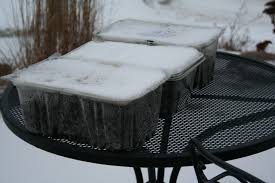Winter Sowing.
- Jason Foster
- Feb 9, 2023
- 2 min read
Ah, winter sowing, the quirky cousin of traditional seed starting methods. Are you tired of spending your hard-earned money on fancy indoor seed starting gear and grow lights? Do you want to try something a little more adventurous and dare I say, a little more fun? Well, then my friend, winter sowing is just for you!

In case you're new to this whole winter sowing thing, let me explain. It's the practice of planting seeds directly in the garden during the winter months, when Mother Nature is wearing her frostiest outfit. The seeds are planted in containers that are left outside to face the elements and when spring arrives, ta-da! You've got yourself some healthy, hardy seedlings ready to be planted in the garden.
So, why should you try winter sowing? Well, for starters, you can save your pennies for more important things, like chocolate and wine. There's no need to invest in expensive indoor seed starting gear, grow lights, or heating mats. And, the best part? You can collect and save your own seeds from year to year, so you'll never have to spend a single cent on seeds again! Winter sowing also has the added benefit of making your seedlings tough as nails. By exposing them to the elements, they'll develop a tough exterior that'll make them better equipped to face the challenges of outdoor gardening. And, who doesn't want a plant that can fend for itself?
So, how do you winter sow?
First, grab a container. Milk jugs, soda bottles, and clear plastic containers are all fair game. Cut the top off and fill it with soil, compost, or seed starting mix. Water, add your seeds, and cover with a thin layer of soil or seed starting mix. Place the lid on the container and secure it with tape or a rubber band. It's like giving your seeds a winter vacation in a fancy, clear-walled resort.
Next, find a location for your containers that's protected from strong winds and excessive sunlight. When spring arrives, move your containers to a sunny location and watch as your seeds sprout and grow into strong, healthy seedlings.
Extra Resource : HOW TO USE MILK JUGS TO SOW SEEDS IN THE WINTER
Now, when is the best time to winter sow? .
Anytime from late fall to early spring, depending on your local climate. In areas with harsh winter conditions, wait until the soil is frozen and the air is cold before planting your seeds. In areas with milder winters, plant your seeds earlier in the season. And, what can you winter sow? Just about anything! Annuals, perennials, vegetables, and herbs are all fair game. Tomatoes, peppers, basil, and zinnias are just a few popular options.
In conclusion, winter sowing is a fun and quirky way to start your plants in the garden. It saves you money, makes your seedlings tough as nails, and allows you to grow a wider variety of plants. So, why not give it a try this winter and see if your green thumb gets a little quirkier too!















Comments